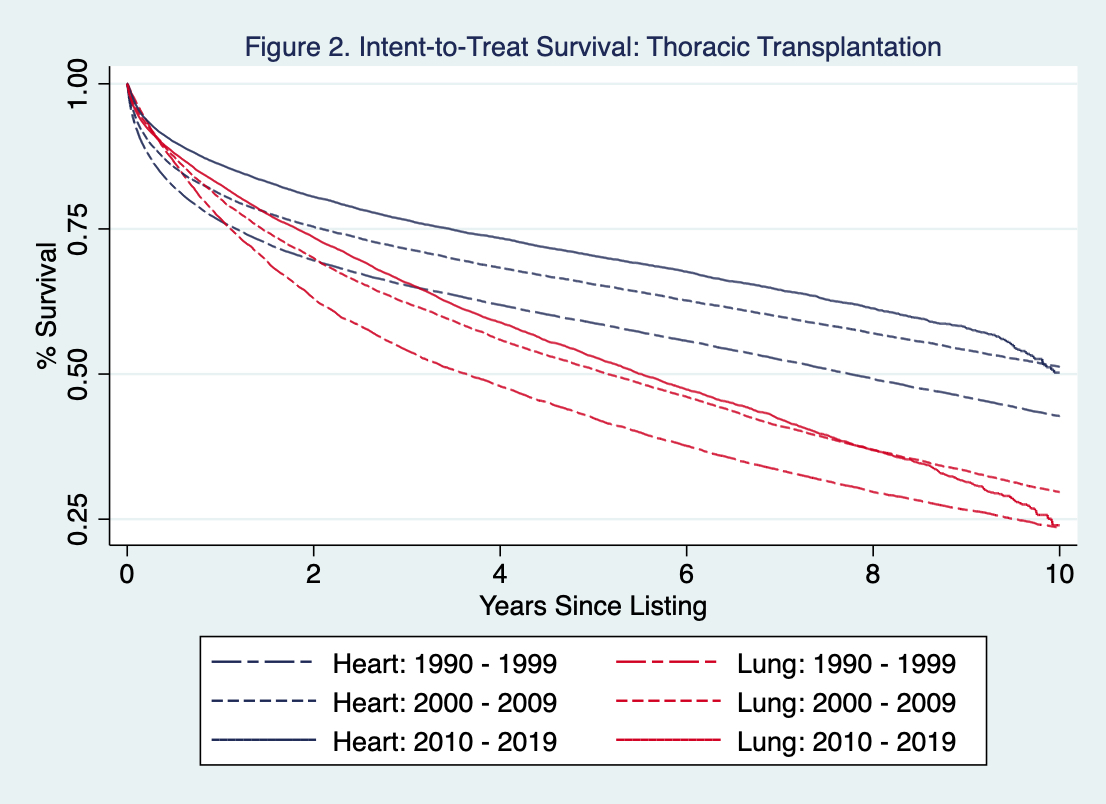A Patient-Centered Perspective on Progress in Transplantation
1Department of Student Affairs, Baylor College of Medicine, Houston, TX, 2Department of Surgery, Baylor College of Medicine, Houston, TX
Meeting: 2021 American Transplant Congress
Abstract number: 395
Keywords: Heart, Kidney, Liver, Lung
Topic: Clinical Science » Biomarkers, Immune Assessment and Clinical Outcomes
Session Information
Session Name: Biomarkers, Immune Assessment and Clinical Outcomes
Session Type: Poster Video Chat
Date: Saturday, June 5, 2021
Session Time: 7:30pm-8:30pm
 Presentation Time: 7:50pm-8:00pm
Presentation Time: 7:50pm-8:00pm
Location: Virtual
*Purpose: This study aimed to provide a patient-centered perspective on change in transplantation outcomes through analysis of intent-to-treat survival, which accounted for donor shortages by following patients from listing to death regardless of whether a transplant was received.
*Methods: The study population consisted of patients in the Organ Procurement and Transplantation Network database listed from January 1, 1990 to December 31, 2019. This included 483,523 patients listed for kidney transplant, 202,096 patients listed for liver transplant, 79,563 patients listed for heart transplant, and 48,680 patients listed for lung transplant. Patients were followed from listing until death or last known follow-up, whether on the waitlist or post-transplant. Cox proportional hazards regression was used to identify clinical and demographic factors associated with intent-to-treat survival. Factors significant in univariate analysis (p < 0.05) were included with decade of listing (1990-1999, 2000-2009, 2010-2019) in multivariate regression, with 2010-2019 used as the reference time period.
*Results: For all organs, listing from 1990-1999 was associated with highest risk of death and listing from 2010-2019 was associated with lowest risk of death. For kidney transplant, hazard ratios (95% confidence intervals) were 1.43 (1.41-1.45) and 1.04 (1.04-1.05) for 1990-1999 and 2000-2009, respectively. Similarly, liver transplant hazard ratios were 1.30 (1.27-1.32) and 1.09 (1.08-1.10), heart transplant hazard ratios were 1.73 (1.67-1.79) and 1.14 (1.12-1.16), and lung transplant hazard ratios were 1.54 (1.49-1.60) and 1.11 (1.09-1.13). Kaplan-Meier survival curves for abdominal and thoracic organs can be seen in Figure 1 and Figure 2, respectively.
*Conclusions: Intent-to-treat outcomes have improved significantly over the last three decades. While all organs displayed improvement in intent-to-treat survival, improvements were most significant in heart and lung transplant. This reflects the combined success of efforts directed at decreasing waitlist mortality, increasing post-transplant survival, and maximizing the respective pools of donor organs.
To cite this abstract in AMA style:
Hickner B, Galvan N, Cotton R, O'Mahony C, Goss J, Rana A. A Patient-Centered Perspective on Progress in Transplantation [abstract]. Am J Transplant. 2021; 21 (suppl 3). https://atcmeetingabstracts.com/abstract/a-patient-centered-perspective-on-progress-in-transplantation/. Accessed July 18, 2025.« Back to 2021 American Transplant Congress


